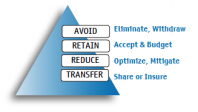Risk: Be Prepared – Take Control

 Have you ever taken a risk tolerance questionnaire with your investment advisor? Our industry developed risk tolerance questionnaires which are a set of multiple choice questions that can usually be completed in less than a minute. Based on your answers, if you’ve scored low, you have a low tolerance for risk; if you’ve scored high you have a higher tolerance for risk, meaning you are a more aggressive investor. This information is supposed to provide a method of structuring your investment portfolio. Unfortunately, those risk tolerance questionnaires are slightly flawed as they are more emotional than financially driven and include a regulatory mandate to determine someone’s risk tolerance.
Have you ever taken a risk tolerance questionnaire with your investment advisor? Our industry developed risk tolerance questionnaires which are a set of multiple choice questions that can usually be completed in less than a minute. Based on your answers, if you’ve scored low, you have a low tolerance for risk; if you’ve scored high you have a higher tolerance for risk, meaning you are a more aggressive investor. This information is supposed to provide a method of structuring your investment portfolio. Unfortunately, those risk tolerance questionnaires are slightly flawed as they are more emotional than financially driven and include a regulatory mandate to determine someone’s risk tolerance.
Risk tolerance questionnaires fail to address one’s individual specific goals and personal circumstances. They ask you about your age, your annual household income (not your spending habits), your investment knowledge etc…They may also ask, “What are your return expectations for your portfolio” or “How would you characterize your personality?” These are the so called emotional questions, which can change like the weather. This is evident when you look at the sales of mutual funds over the past years. In 2007, net sales were $33.49 billion; versus $107.8 million in 2008 after the market crashed. Industry net sales for 2013 were $41.9 billion and we are on course for another record year in 2014.
Looking back, it is easy to see that one’s tolerance to risk changes based on the market conditions - very little new money went into the market when the investments were “on sale” at really great prices. If you fast forward to today you will notice one’s risk tolerance is much different than 5 years ago. This is evident with new deposits going into the market in record numbers - when investments are no longer “on sale”. Investors are more optimistic when the market goes up and more pessimistic when the market goes down.
Hence the saying “Canadians love to buy high and sell low!” When a crisis event occurs—next time remember the old saying—“turn lemons into lemonade”.
Now, let’s look at some definitions of risk. Risk is defined as:
- the potential of losing something of value;
- the chance of something going wrong;
- the outcome will be different than expected.
There are many different definitions for the word risk and it is not surprising that our industry and investors find it a challenge to determine one’s true risk tolerance. One of our personal favourite definitions of risk is defined as ‘the degree to which an outcome varies from expectation’. We all know we have no control of the future and risk is all about the future; that is why it is so important to plan and hence so important to have a well thought out financial plan in place.
Keep in mind we can’t always eliminate risk but we can try to manage risk. The best way to manage risk is by first identifying the risk. We suggest you list your top three risks - these are things that keep you awake at night. For example, running out of money before running out of life or helping your adult kids out financially but at what price? ……..Your retirement dreams…. Remember the saying KIPPERS - ‘Kids In Parents Pockets Eroding Retirement Savings’. Is that one of your risks? Take a moment to list your top three major concerns or risks.
Now that you have an idea about your personal risks, you need to truly understand and prioritize them. You do this by focusing on the risks that have the highest impact and the highest probability to those with the lowest probability and the lowest impact. Are there are any other worries or concerns not on your list? It is extremely important to address all your risks. Don’t bury your head in the sand. Sometimes the risk with the highest impact and the highest potential are not on the list….. Don’t be in denial. Remember all progress begins with the truth.
Now that you have created your list you can explore the various opportunities to help manage them. You have four choices.
For example, one of your greatest risks may be not having enough money in retirement. You are now aware what the risk is and the impact, but you have control. Do you reduce your spending today and increase your savings over the next five years? Or maybe it means delaying retirement for the next five years. This would either minimize or eliminate this risk.
When it comes to managing retirement risks, there are really only 3 risk management tactics available, because the option to AVOID a risk is poor planning.
The remaining options are:
- RETAIN the risks and either prepare for or deal with the consequences;
- REDUCE exposure as much as possible and hope that an out-of-ordinary event does not happen; or,
- TRANSFER the risk to a third party who can provide protection. Buying a Life Income Annuity from an insurance company is a perfect example.
Once your risks have been identified, prioritized and risk management plans implemented, it is crucial to continue to ensure you are still on track. Modify and update accordingly and always be on the lookout for potential new risks. The result of the risk management process is understanding your role in managing the risks and the trade-offs that must be made. We all know life happens, remember the scouting/guiding motto—be prepared.
Next time you are asked to complete a risk tolerance questionnaire, make sure it also includes a lengthy discussion about risk and how you define and perceive risk.
Ian Burns, CLU, ChFC, EPC and Shelley Johnston, CFP, EPC, The Pension Specialists, Authors of “Pay Attention to Your Pension”, Whitby, ON, (888) 279-0622, info@ pensionspecialists.ca, www.payattentiontoyourpension.ca

